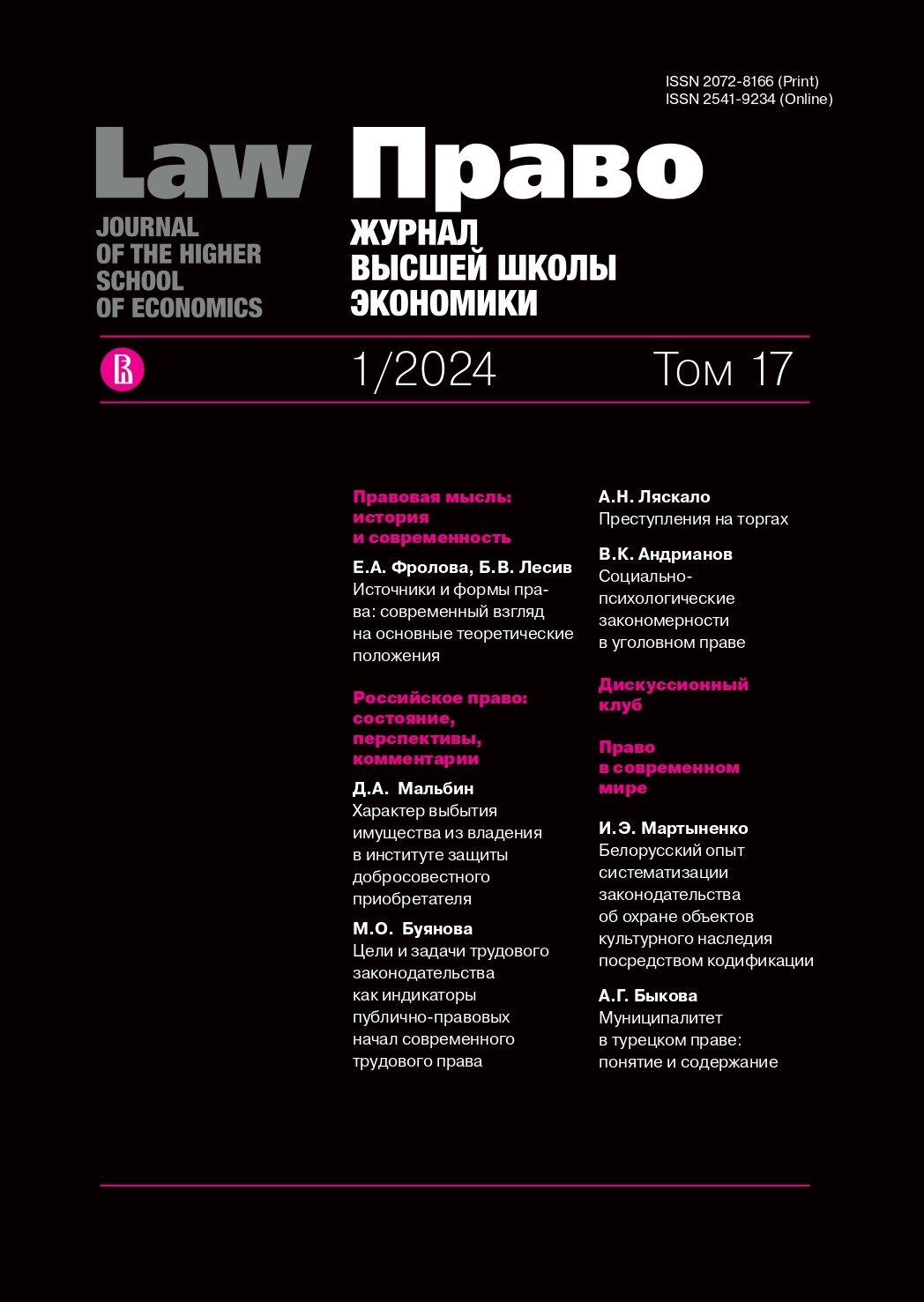Фронтир биологии и горизонты юриспруденции: влияние исследования природы человеческой агрессии на развитие уголовной юстиции
Аннотация
Стремительный рывок, произошедший за последние десятилетия в области нейробиологии и молекулярной генетики, актуализировал проблему познания нейронных и генетических основ социально значимого поведения. В результате все больше ученых в области социальных и поведенческих наук начинает проявлять интерес к подобным исследованиям с целью сверки и корректировки результатов своих работ в данном направлении. Юриспруденция и в первую очередь уголовно-правовые науки, не являются в данном случае исключением. В кругу их специалистов уже давно циркулирует мнение о том, что методики исследований, реализуемые в науках естественно-научного цикла, и добываемые посредством их данные имеет смысл последовательно внедрять в практику правоохранительной деятельности. В статье содержатся результаты анализа ключевых тенденций в области использования нейробиологической и генетической информации в рамках уголовного судопроизводства США по делам о тяжких насильственных преступлениях. К ним следует отнести: последовательный рост числа рассматриваемых уголовных дел, включающих данные нейробиологических исследований; отсутствие у нейробиологических доказательств постоянного «смягчающего» эффекта; более благожелательное восприятие судом и присяжными нейроданных, представляемых стороной защиты по делам о преступлениях несовершеннолетних; увеличение доли апелляционных жалоб обвиняемых на игнорирование либо неэффективное использование их защитниками нейробиологической информации (в рамках «стандарта Стрикленда») и при этом непропорционально большой процент их удовлетворения; фактическое требование судом от адвокатов постоянного мониторинга новейших исследований в данной области, при одновременном применении аналогичного стандарта качества профессиональной деятельности и по отношению к самому себе. Отмечая расхождение этих правоприменительных тенденций с положениями традиционных социологических теорий, объясняющих природу происхождения социальных девиаций, автор формулирует ряд полемических тезисов, научное и практическое обсуждение которых, по его мнению, способно определить перспективы использования достижений биологической науки для развития отечественной сферы уголовной юстиции.
Литература
Alferova E.V. (2023) Neurobiotechnologies, criminal law and process: the view of Russian scientists: a review. Sotsial'nyye i gumanitarnyye nauki. Otechestvennaya i zarubezhnaya literatura. Referativnyy zhurnal=Social Sciences and Humanities. Domestic and Foreign Literature. Abstract Journal, no. 2, pp. 206-216 (in Russ.)
Aono D., Yaffe G., Kober H. (2019) Neuroscientific evidence in the courtroom: a review. Cognitive Research: Principles and Implications, 2019, vol. 4, no. 1, pp. 1-20. DOI: https://doi.org/10.1186/s41235-019-0179-y
Beaver K.M. et al. (2014) The nurture versus biosocial debate in criminology: On the origins of criminal behavior and criminality. London: SAGE Publications, 472 p. DOI: https://doi.org/10.4135/9781483349114
Beaver K.M., Walsh A. (ed.) (2009) Biosocial criminology: new directions in theory and research. New York: Routledge, 285 p.
Bernet W. et al. (2007) Bad nature, bad nurture, and testimony regarding MAOA and SLC6A4 genotyping at murder trials. Journal of Forensic Sciences, vol. 52, no. 6, pp. 1362-1371. DOI: https://doi.org/10.1111/j.1556-4029.2007.00562.x
Bibas S. (2004) Psychology of hindsight and after-the-fact review of ineffective assistance of counsel. Utah Law Review, no. 2, pp. 1-11. DOI: https://doi.org/10.2139/ssrn.460447
Brunner H.G. et al. (1993) Abnormal behavior associated with a point mutation in the structural gene for monoamine oxidase A. Science, vol. 262, no. 5133, pp. 578-580. DOI: https://doi.org/10.1126/science.8211186
Brunner H.G. (2007) MAOA deficiency and abnormal behaviour: perspectives on an association. In: Ciba Foundation Symposium 194 Genetics of Criminal and Antisocial Behaviour: Genetics of Criminal and Antisocial Behaviour: Ciba Foundation Symposium 194. Chichester: John Wiley & Sons, pp. 155-167. DOI: https://doi.org/10.1002/9780470514825.ch9
Burke R.H. (2021) Contemporary criminological theory: crime and criminal behaviour in the age of moral uncertainty. New York: Routledge, 543 p. DOI: https://doi.org/10.4324/9781351242097
Caspi A. et al. (2002) Role of genotype in the cycle of violence in maltreated children. Science, vol. 297, no. 5582, pp. 851-854. DOI: https://doi.org/10.1126/science.1072290
Davidson R.J. et al. (2000) Dysfunction in the neural circuitry of emotion regulation--a possible prelude to violence. Science, vol. 289, no. 5479, pp. 591-594. DOI: https://doi.org/10.1126/science.289.5479.591
DeLisi M., Vaughn M.G. (ed.) (2018) The Routledge international handbook of biosocial criminology. New York: Routledge, 689 p. DOI: https://doi.org/10.4324/9781315111476
Denno D.W. (1988) Human biology and criminal responsibility: Free will of free ride. University of Pennsylvania Law Review, vol. 137, no. 2, pp. 615-671. DOI: https://doi.org/10.2307/3312255
Denno D.W. (2011) Courts' increasing consideration of behavioral genetics evidence in criminal cases: results of a longitudinal study. Michigan State Law Review, pp. 967-1047.
Denno D.W. (2015) The myth of the double-edged sword: An empirical study of neuroscience evidence in criminal cases. Boston College Law Review, vol. 56, pp. 493-551.
Farahany N.A. (2015) Neuroscience and behavioral genetics in US criminal law: an empirical analysis. Journal of Law and the Biosciences, vol. 2, no. 3, pp. 485-509.
Farahany N.A., Kennedy R.T., Garrett B.L. (2020) Genetic Evidence, MAOA, and State v. Yepez. New Mexico Law Review, vol. 50, pp. 469-487.
Focquaert F. (2019) Neurobiology and crime: A neuro-ethical perspective. Journal of Criminal Justice, vol. 65. DOI: https://doi.org/10.1016/j.jcrimjus.2018.01.001
Glenn A.L., Raine A. (2014) Neurocriminology: implications for the punishment, prediction and prevention of criminal behavior. Nature Reviews Neuroscience, 2014, vol. 15, no. 1, pp. 54-63. DOI: https://doi.org/10.1038/nrn3640
Kholmogorova A.B., Rychkova O.V. (2017) 40 years of the biopsychosocial model: what's new? Sotsial'naya psikhologiya i obshchestvo=Social Psychology and Society, vol. 8, no. 4, pp. 8-31 (in Russ.) DOI: https://doi.org/10.17759/sps.2017080402
Kudryavtseva N.N., Markel A.L., Orlov Yu.L. (2014) Aggressive behavior: genetic and physiological mechanisms. Vavilovskiy zhurnal genetiki i selektsii=Vavilov Journal of Genetics and Breeding, vol. 18, no. 4, pp. 1133-1155 (in Russ.)
Lilly J.R. et al. (2019) Criminological theory: Context and consequences. London: Sage Publications, 1027 p.
Markel A.L. (2016) Biosocial foundations of aggressiveness and aggressive behavior. Zhurnal vysshey nervnoy deyatel'nosti im. I.P. Pavlova=Pavlov Journal of Higher Nervous Activity, vol. 66, no. 6, pp. 669-681(in Russ.)
Martell D.A. (1992) Forensic neuropsychology and the criminal law. Law and Human Behavior, vol. 16, no. 3, pp. 313-336. DOI: https://doi.org/10.1007/BF01044772
Moffitt T.E. (1993) Adolescence-limited and life-course-persistent antisocial behavior: a developmental taxonomy. Psychological Review, vol. 100, no. 4, pp. 674-701. DOI: https://doi.org/10.1037//0033-295X.100.4.674
Morse S.J. (2011) Genetics and criminal responsibility. Trends in Cognitive Sciences, vol. 15, no. 9, pp. 378-380. DOI: https://doi.org/10.1016/j.tics.2011.06.009
Odintsova V.V. et al. (2019) Genomics of human aggression: current state of genome-wide studies and an automated systematic review tool. Psychiatric Genetics, vol. 29, no. 5, pp. 170-190. DOI: https://doi.org/10.1097/YPG.0000000000000239
Pavlov K.A. et al. (2012) Genetic determinants of aggression and impulsivity in humans. Journal of Applied Genetics, vol. 53, no. 1, pp. 61-82. DOI: https://doi.org/10.1007/s13353-011-0069-6
Polubinskaya S.V. (2021) The neuro lie detector. Soyuz kriminalistov i kriminologov=Union of Criminalists and Criminologists, no. 1, pp. 7-14 (in Russ.) DOI: https://doi.org/10.31085/2310-8681-2021-1-204-7-14
Polubinskaya S.V. (2019) Use of neuroscience data in the doctrine of criminal law and judicial practice. Trudy Instituta gosudarstva i prava Rossiyskoy akademii nauk=Proceedings of the Institute of State and Law, Russian Academy of Sciences, vol. 14, no. 5, pp. 9-37 (in Russ.) DOI: https://doi.org/10.35427/2073-4522-2019-14-5-polubinskaya
Polubinskaya S.V. (2022) Using the results of genetic research in the field of criminal justice. Soyuz kriminalistov i kriminologov=Union of Criminalists and Criminologists, no. 1, pp. 21-30 (in Russ.) DOI: https://doi.org/10.31085/2310-8681-2022-1-192-21-30
Popma A., Raine A. (2006) Will future forensic assessment be neurobiologic? Child and Adolescent Psychiatric Clinics, vol. 15, no. 2, pp. 429-444. DOI: https://doi.org/10.1016/j.chc.2005.11.004
Rafter N.H. et al. (2016) The criminal brain: understanding biological theories of crime. New York: NYU Press, 284 p. DOI: https://doi.org/10.18574/nyu/9781479825745.001.0001
Rietveld C.A. et al. (2013) GWAS of 126,559 individuals identifies genetic variants associated with educational attainment. Science, vol. 340, no. 6139, pp. 1467-1471. DOI: https://doi.org/10.1126/science.1235488
Rose N. (2000) The Biology of Culpability: Pathological Identity and Crime Control in a Pathological Culture. Theoretical Criminology, vol. 4, no. 1, pp. 5-34. DOI: https://doi.org/10.1177/1362480600004001001
Rosell D.R., Siever L.J. (2015) The neurobiology of aggression and violence. CNS Spectrums, vol. 20, no. 3, pp. 254-279. DOI: https://doi.org/10.1017/S109285291500019X
Scurich N., Appelbaum P.S. (2017) Behavioral genetics in criminal court. Nature Human Behavior, vol. 1, no. 11, pp. 772-774. DOI: https://doi.org/10.1038/s41562-017-0212-4
Scurich N., Appelbaum P.S. (2021) State v. Yepez: Admissibility and Relevance of Behavioral Genetic Evidence in a Criminal Trial. Psychiatric Services, vol. 72, no. 7, pp. 853-855. DOI: https://doi.org/10.1176/appi.ps.202100226
Shkurko Yu. S. (2020) Biosociology and the Standard Model of Social Sciences: in search of the golden mean. Vestnik Tomskogo gosudarstvennogo universiteta=Bulletin of Tomsk State University, no. 455, pp. 91-96 (in Russ.) DOI: https://doi.org/10.17223/15617793/455/13
Sudakova T.M. (2022) Neuroscience and neurocriminology: methodological principles of integration. Akademicheskiy yuridicheskiy zhurnal=Academic Legal Journal, vol. 23, no. 2, pp. 179-186 (in Russ.) DOI: https://doi.org/10.17150/1819-0928.2022.23(2).179-186
Tremblay R.E. et al. (2018) Developmental origins of chronic physical aggression: a bio-psycho-social model for the next generation of preventive interventions. Annual Review of Psychology, vol. 69, no.1, pp. 383-407. DOI: https://doi.org/10.1146/annurev-psych-010416-044030
Trifu S.C. et al. (2020) Aggressive behavior in psychiatric patients in relation to hormonal imbalance. Experimental and Therapeutic Medicine, vol. 20, no. 4, pp. 3483-3487. DOI: https://doi.org/10.3892/etm.2020.8974
Volkow N.D., Tancredi L. (1987) Neural substrates of violent behaviour a preliminary study with positron emission tomography. The British Journal of Psychiatry, vol. 151, no. 5, pp. 668-673. DOI: https://doi.org/10.1192/bjp.151.5.668
Walters G.D. (2022) Criminality and crime: A social-cognitive-developmental theory of delinquent and criminal behavior. Boulder: Rowman & Littlefield, 311 p. DOI: https://doi.org/10.5771/9781666904437-311
Zhang-James Y. et al. (2019) An integrated analysis of genes and functional pathways for aggression in human and rodent models. Molecular Psychiatry, vol. 24, no. 11, pp. 1655-1667. DOI: https://doi.org/10.1038/s41380-018-0068-7
Copyright (c) 2024 Право. Журнал Высшей школы экономики

Это произведение доступно по лицензии Creative Commons «Attribution-ShareAlike» («Атрибуция — На тех же условиях») 4.0 Всемирная.


















